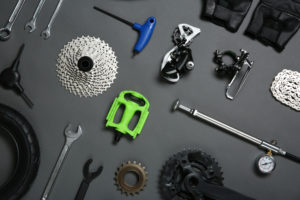Imagine walking at 15 MPH. That’s right, walking a 4-minute mile! Well, that’s exactly what a bicycle can do for you on a good day. There is no more efficient form of transport than the bicycle. And when it comes to carrying the most weight with the least effort, the bicycle again wins hands-down.
A well-tuned bicycle will transfer upwards of 99% of the energy applied to the pedals directly to the wheels. Average humans can pedal along
SKIP AHEAD
The Modern Bike Store
A quick trip to the bike store will prove there are few traditions left in bike designs. Two recent deviations from the conventional looking bike include freight bicycles that easily carry 200 pounds of cargo, and a fairly new but wildly conspicuous class of bike that has not yet found a common label. The reason this latter category of bike is important is because it just might become the Ultimate Bug Out Bike. General names for this genera of bike include “Superfat Tire” “Omniterra” and “You know, that bike with the huge tires.” One company uses the appropriate moniker “Moon Lander” for their version of this five-inch wide tire mountain bike. Five inches! A traditional mountain bike has a tire about two inches plus or minus. A road bike has a tire between an inch and an inch and a half. But five inches wide? You could ride over snow and sand. And that’s the point.
Bug Out Bike Considerations
No matter what you ride, here are some considerations to keep in mind when the bike moves from the realm of exercise to that of survival. The following observations are for the less-seasoned cyclists who may have little experience in the bicycle repair department.
First of all, if you don’t have a medium to good quality mountain bike, get one now. Waiting until things go south before shopping for a two-wheeler is not wise. Once the simpler life is pressed upon us, bicycles will be worth more than a Cadillac. One does not have to shell out a thousand dollars for a good survival bike. There are plenty of used mountain bikes that will work fine (Craigslist – Bikes). Stick to the name brands, and have some extra tires, tubes, and cables on hand, and keep the moving parts lubed up, especially the chain.
The transient and homeless bicyclists riding around most cities are masters of putting the pieces together into something ride-able. Kind of a pedal-powered Mad Max world, if you like. While a “Frankenbicycle” is not the most desirable pathway to transportation, let alone a comfortable ride, it should be noted that there are plenty of examples of just how bad a bike can get and yet it’s still possible to roll around with relative ease.
Be aware that if you haven’t ridden a bicycle in a long time, it’s going to hurt. And the next time you hop on the saddle its going to hurt worse. But it won’t kill you. After years or decades of non-riding you will have a sore butt, sore knees, sore muscles, sore arms, and a sore neck. But not for long. Your body will quickly adapt to the riding position and only your butt will require more than a few days to get used to it. Give it a week before you complain. Other people are much worse off than you.
Maintenance
Bicycles are the ultimate of simplicity, but still require maintenance. The more weight you carry, the faster the tires wear out. The harsher the climate, the more rust causes cables and bolts to break. Also the more sunlight, the sooner the non-metallic parts disintegrate.
Bikes are elegant expressions of pure physics. Every part has been honed down to minimal weight and maximum performance. Each component does its job visibly and without magical computer chips or complex mechanisms. What this means is that there are better ways and worse ways to fix a bike, but any way that gets you riding again is a good way.
Wheels are essential. There is no denying the importance of the so-called spinning mass of a bicycle. It’s the anchor to balancing, the key to minimal rolling resistance, and the main shock absorber between your planet earth and your butt. The tires need something inside them between the rubber and the rim. Air is preferable, but dirt, pine needles, tree bark, even old clothes can make do in a pinch. Just don’t expect your usual rolling performance with grandma’s old dress substituting as an inner tube.
Broken rims are usually a deal breaker, but broken spokes are an annoyance. Depending on the number of spokes, you may not need to replace the broken one. In that case, a gentle tightening of the spokes on the opposite side of the hub from the broken one will true-up your wheel good enough to forget about it. If the broken spoke was critical but cannot be replaced, then hopefully there is enough spoke left on each side of the break to bend into hooks that can be attached together with scrap wire.
The drive-train must work somehow even if the chain links are cobbled together with wire. In a multi-geared bike, as links are removed from the chain it just gets shorter, but no less effective. Fewer gear combinations will work, but as long as one gear works, you’re ahead in this game. A stick or other object can be wedged in the derailleur to lock-in a particular gear if the cables are compromised or the mechanism is bent. Think of gear skips, hops and miss-shifts as nothing more than annoyances. If you can pedal, you can move.
Brakes and gear shifting are nice but not essential. If you can get at least one gear working, and you keep your speed under control, you are good to go. In third-world countries, some of the bikes that are ridden daily are barely recognizable as bicycles to westerners. Sure there are two wheels and a frame, but while our options around here are carbon fiber bottle cages and integrated crank arm wattage meters, over there the options might be seats, a left handlebar, and two pedals.
In a pinch, knots can be used to tie broken cables together and tie-off punctured inner tubes. There’s no rule that says inner tubes must go all the way around a wheel. Cut the tube in half at the puncture; tie a couple of knots, and inflate as usual. Zip ties, twisted wire, and duct tape can also work and will recover much of the tube length wasted in a knot. Be creative. If it works, it works. Just keep your speed down as the forces increase with acceleration.
Zip-ties can also replace lost or broken bolts, as can a few loops of wire twisted tight like a tourniquet. And you could probably fabricate most bike parts out of duct tape and scrap metal when push comes to SHTF.
The 6 Essential Bike Tools
Ideally, proper bike tools should be on hand. The simplicity of the modern bicycle limits the reasonable number of tools needed for general maintenance to a pretty short list. It would be easy to argue that the most important tool is the one you need, but based on frequency of use, the must-have tools sort themselves out fairly quickly.
1. Hex wrenches of 4, 5, and 6mm.
2. Socket or open-end wrenches of 8, 9, and 10mm.
3. Slotted and #2 Phillips screwdrivers.
4. Small air pump that works with both schrader and presta valves.
5. Inner tube patch kit containing patches, rubber cement, and sandpaper.
6. Chain tool. A nail and rock works too. Just don’t punch the pin all the way out!
3 General-use Tools
1. Adjustble wrench (aka: Crescent wrench). My favorites is the Snap-On ADHW6 because even though it’s only a 6-inch size, the jaws open larger than 1 ¼ inches.
2. Slip-joint pliers. A good choice is the Knipex 8801180. This particular plier weighs only 6.3 ounces, but has jaws that open up to one an half inches allowing it to grab many headset nuts. It is also narrow enough to tighten the 15mm pedal spindle.
3. A multi-tool like the Leatherman Wave with its accessory Bit Kit. It adds redundancy in some essential tools, adds a needle nose pliers, a metal file, a saw, and two knives.
A word about bicycle-specific multi-tools. While many of them are handy, they can have significant shortcomings as well over workshop-level tools. Many of the all-in-one tools seem to be designed more with artistic expression than functionality. A few notable issues include the drivers being too short, the shape or size of the tool prevents it from rotating in the available space, the lack of leverage, and the inability to use two tools at the same time. My suggestion is to supplement your tool kit with very simple bike-specific multi-tools rather than the 20-in-one Swiss Army type. It’s maddening when the beer bottle opener on your bike tool impedes your ability to tighten the seat post.
A little knowledge of bike repair will make as big a difference as having the right tools, so thumb through a bike repair book to familiarize yourself with the bike parts and the adjustments. We all know the old saying about using the right tool for the job… when the right tool is available. But what if all you have is a rock? Well, most bike parts are made of soft metal so possibly the part could be bent or pounded back into service. Of course the lifespan of the component is reduced, but it’s your life we’re worried about, not the life of the left crank arm.
Every bike on this planet is a card-carrying organ donor so with minimal engineering skills you can cannibalize parts from other bicycles breathing eternal life to your survival Frankenbike.
Stay tuned for Part 2.





